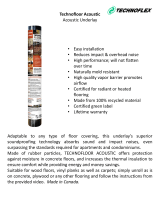
Installation
5. All other subfloors - Plywood, OSB, particleboard, chipboard, wafer board, etc. must be structurally sound and must be installed
following their manufacturer’s recommendations. Local building codes may only establish minimum requirements of the flooring
system and may not provide adequate rigidity and support for proper installation and performance. If needed add an additional
layer of
APA rated underlayment, fasten and secure according to the underlayment manufacturer’s recommendations.
6. Resilient flooring is not recommended directly over fire-retardant treated plywood or preservative treated plywood. An additional
layer of APA rated 1/4" thick underlayment should be installed.
B. CONCRETE SUBFLOORS
NEW AND EXISTING CONCRETE SUBFLOORS SHOULD MEET THE GUIDELINES OF THE LATEST EDITION OF ACI 302
AND ASTM F 710, “STANDARD PRACTICE FOR PREPARING CONCRETE FLOORS TO RECEIVE RESILIENT FLOORING”
AVAILABLE FROM THE AMERICAN SOCIETY FOR TESTING AND MATERIALS, 100 BARR HARBOR DRIVE, WEST
CONSHOHOCKEN, PA 19428; 610-832-9585; HTTP://WWW.ASTM.ORG.
1. Floors shall be smooth, permanently dry, clean, and free all foreign material such as dust, wax, solvents, paint, grease, oils, and
old adhe
sive residue. The surface must be hard and dense, and free from powder or flaking.
2. Concrete slabs must be dry with no visible moisture.
3. Required Moisture Testing - maximum moisture level per ASTM 1869 CaCl is 8 lbs. and ASTM 2170 In-situ Relative
Humidity90% per 1000 sq.ft. in 24 hours.
4. Do not install over concrete with a history of high moisture or hydrostatic conditions. Excessive moistur
e in the subfloor could
promote mold, mildew, and other moisture related issues like the trapping of moisture emissions under the flooring, which may
contribute to an unhealthy indoor environment. Shaw Industries does not warrant nor is responsible for damage to floor covering
due to moisture related issues.
5. pH level of concrete should be between 7-10.
6. The final responsibility for determining if
the concrete is dry enough for installation of the flooring lies with the floor covering
installer.
NOTE: IT MAY NOT BE THE FLOOR COVERING INSTALLER'S RESPONSIBILITY TO CONDUCT THESE TESTS. IT IS,
HOWEVER, THE FLOOR COVERING INSTALLER'S RESPONSIBILITY TO MAKE SURE THESE TESTS HAVE BEEN
CONDUCTED, AND THAT THE RESULTS ARE ACCEPTABLE PRIOR TO INSTALLING THE FLOOR COVERING. WHEN
MOISTURE TESTS ARE CONDUCT
ED, IT INDICATES THE CONDITIONS ONLY AT THE TIME OF THE TEST.
LIGHTWEIGHT CONCRETE
All recommendations and guarantees as to the suitability and performance of lightweight concrete under resilient flooring are the
responsibility of the lightweight concrete manufacturer. The installer of the lightweight product may be required to be authorized or
certified by the manufacturer. Correct on-site mixing rat
ios and properly functioning pumping equipment are critical. To ensure proper
mixture, slump testing is recommended.
Lightweight aggregate concretes having dry densities greater than 90 lbs. per cubic foot may be acceptable under resilient
flooring.
Concrete slabs with heavy static and/or dynamic loads should be designed with higher strengths and densities to support such
loads.
Surface must be permanently dry, clean, smooth, free of all dust, and structurally sound.
Perform Bond testing to determine compatibility of adhesive to the substrate. Shaw 9050 primer (or equivalent/comparable
primer) can be utilized to promote adhesion.
Three internal relative humidity tests should be conducted for areas up to 1000 sq. ft. One additional test, for each additional
1000 sq. ft.
Radiant Heating: Radiant-heated subfloor systems can be concrete, wood or a combination of both.
The heating systems components must have a minimum of 1/2" separation from the flooring product. The system must be on and
operational for at least 2 weeks prior to
installation to reduce residual moisture. Three days prior to installation lower the temperature to
65°F, after installation gradually increase the temperature in increments of 5°F to avoid overheating. Maximum operating temperature
should never exceed 85°F. Use of an in-floor temperature sensor is recommended to avoid overheating. Contact the manufacturer of
your radiant heating system for further r
ecommendations.
2
For reference purposes only if printed or downloaded.











